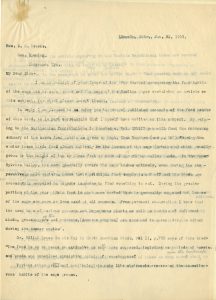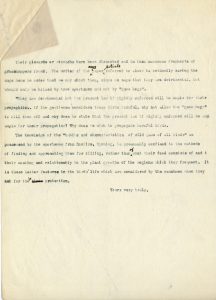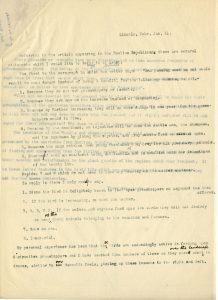Great Nebraska
Naturalists and ScientistsNOU, Lawrence Bruner, letter, 1904, Jan. 21
 Lincoln, Nebr., Jan. 21, 1904.
Lincoln, Nebr., Jan. 21, 1904.
Hon. B. B. Brooks, Gov. Wyoming. Cheyenne, Wyo.
My Dear Sir:- I am in receipt of your favor of the 19th instant concerning the food habits of the sage hen or sage grouse and the copy of the Rawlins paper containing an article on this subject, for which please accept thanks.
In reply I am pleased to refer you to several published accounts of the food habits of this bird, to in part corroborate what I myself have written on this subject. By refering to the Smithsonian Contributions to Knowledge, Vol. XXVIII you will find the following summary of the birds food habits as given by Capt. Chas Bandiro (see p. 107) “During the winter these birds feed almost entirely on the leaves of the sage (Arte[illegible]) which usually grows to the height of two or three feet in some of the richer valley lands. In the upper Sylvies Valley, the snow generally covers the sage bushes entirely, even during the comparatively mild winters, hence their principal food supply is cut off and the birds are necessarily compeled to migrate in order to find something to eat. During the greater portion of the year their food is much more varied than is generally supposed but leaves of the sage are more or less used at all seasons. From personal observation I know that the seed tops of various grasses and leguminous plants as well as berries of different kinds, grasshoppers and crickets, (Amorun simplex) are consumed to a considerable extent during the summer months”.
Dr. Elliot Copes in his Key to North American Birds, Vol II, p.755 says of this bird- “The food is by no means so exclusive as some have supposed, including many kinds of berries and seeds and sometimes consisting mainly of grasshoppers.” Various other prominent ornithologists make like statements concerning the insectivorous habits of the sage grouse.
Referring to the article appearing in the Rawlins Republican, there are several statements which I would like to refer to at least.
The first is the paragraph in which the writer says “And passing such an act would result in much damage instead of being a benefit for the following reasons, to wit.- 1. Because they do not eat grasshoppers or insects. 2. Because they are now on the increase instead of decreasing. 3. Because by further increasing they will do more damage in one year than the grasshoppers would in five. 4. Because by the enactment, an injustice will be done the cattle men, the sheepmen, and the ranchmen by giving the coyotes, and gray wolves food to subsist upon. 5. Because the sage chicken when young furnishes many prey for all predatory animals. 6. Because of such an enactment being detrimental and in conflict with the intentions of the bounty law. Besides 7 and 8 which do not seem to have any bearing on the matter whatever.
In reply to there I only need to say. 1. Since the bird is definitely known to feed upon grasshoppers no argument has been offered.
2. If the bird is increasing, so much the better. 3, 4, 5 & 6. If the wolves and coyotes feed upon the birds they will not destroy so many of the young animals belonging to the ranchmen and farmers. 7. Same as one. 8. Immaterial
My personal experience has been that these birds are exceedingly active in feeding upon destructive grasshoppers and I have watched them numbers of times as they moved about over the landscape in droves, similar to our domestic fowls, picking up these insects to the right and left.
 Their gizzards or stomachs have been dissected and in them numerous fragments of grasshoppers found. The writer of the newspaper article referred to above is evidently saving the sage hens in order that he may shoot them, since he says that they are detrimental, but should only be killed by true sportsmen and not by “game hogs”.
Their gizzards or stomachs have been dissected and in them numerous fragments of grasshoppers found. The writer of the newspaper article referred to above is evidently saving the sage hens in order that he may shoot them, since he says that they are detrimental, but should only be killed by true sportsmen and not by “game hogs”.
“They are detrimental but the present law if rigidly enforced will be ample for their propogation. If the gentleman considers these birds harmful, why not allow the “game hogs” to kill them off and why does he state that the present law if rigidly enforced will be ample for their propagation? Why does he wish to propogate harmful birds.
The knowledge of the “habits and characteristics of wild game of all kinds” as possessed by the sportsman from Rawlins, Wyoming, is presumably confined to the methods of finding and approaching them for killing, rather than of what their food consists of and their nesting and relationship to the plant growths of the regions which they frequent. It is these latter features in the birds’ life which are considered by the ranchmen when they ask for their protection. Yours very truly,
